Share

When it comes to plumbing, there are many issues that can arise. Leaky pipes, clogs in the sink or bathtub drains, and even frozen pipe problems are common examples of things you might encounter when dealing with plumbing. Here are how to fix common plumbing issues and ways to resolve them!
How Do You Diagnose Plumbing Problems?
The first step in diagnosing a plumbing problem is to identify the source of the issue. This can be done by inspecting the fixtures and pipes for signs of leaks, corrosion, or blockages. You may also need to check the water pressure and test the drainage system. Once you have identified the source of the problem, you can begin to troubleshoot it.
How To Fix Common Plumbing Issues
1. Leaky Pipes
What to do: The first thing you’ll want to check is whether or not the water leak has been fixed by turning off your mainline. Once this has been done, you can then go ahead and inspect each of the valves located throughout your home in order to figure out where exactly the issue lies. If there are any signs that corrosion may be at play, make sure to call a professional plumber right away!
2. Clogged Drains
What to do: One way that you could potentially resolve clogged drains on your own would be with some drain cleaner.
Make sure when using chemical-based cleaners like these, however, that it’s diluted according to its instructions so as not to cause damage to your pipes. If this doesn’t seem to be working, you can also try using a plunger on the drain’s opening.
3. Frozen Pipes
What to do: One of the most common plumbing issues during winter is frozen pipes. In order to prevent this from happening, it’s important that you insulate any exposed piping located in crawlspaces and attics with foam insulation sleeves.
However, if you have already experienced frozen pipes, make sure to immediately thaw them out by using hot water or a heat gun (be careful not to apply too much heat at once). Once they are thawed, turn your faucet on slowly until water begins flowing again.
4. Running Toilet
What to do: One of the most common causes for a running toilet is that there may be air bubbles in your tank, which means that you’ll need to hold down the flush valve until it fills with water. If this doesn’t seem to fix the issue, however, then have a look at what’s going on with your float cup, if it has been knocked askew by debris or some other object (such as toys), this can cause issues such as those described above.
5. Low Water Pressure
What to do: One of the most common reasons for low water pressure is sediment buildup in your pipes.
To try and resolve this issue, you can pour a pot of boiling water down each of your fixtures one at a time. If this doesn’t seem to help matters, it might be time to call in a professional plumber who can inspect your entire system.
6. Leaky Faucet
What to do: A leaky faucet may not seem like a big deal, but over time it can seriously increase your monthly water bill. In order to fix this issue, you’ll need to replace the washer inside the faucet head –, this is an easy job that most people can do themselves.
7. No Hot Water
What to do: The last of the common plumbing issues is when you have no hot water. This could be due to a number of reasons, such as a tripped breaker or a faulty thermostat.
Before calling in a professional plumber, make sure to check these things first and see if they might be the root of the problem. If it seems like everything is in order, then give your local plumbers a call!
These are just some of the most common plumbing issues you may encounter, but don’t worry. With these steps, you should be able to resolve them yourself without any trouble at all! For more information on fixing plumbing problems, visit our website today!
How Do You Stop Plumbing Problems?
Here are some tips for stopping your plumbing problems before they become bigger issues:
Solve the problem immediately. Do not let water sit in a toilet bowl or sink to avoid having clogs and backups later on.
Fix leaky faucets as soon as you notice them by replacing worn washers, O-rings, etc. Avoid dripping faucets, since they can waste up to three gallons of water per day.
Make sure you have the right tools for the job. Call a professional if you are not comfortable fixing a plumbing problem yourself.
Be prepared for emergencies. Keep a plunger and some basic supplies like plumber’s tape on hand in case of a plumbing emergency.
Avoid flooding by keeping your gutters and storm drains free of debris. You can also get a rain barrel to collect excess water from your roof for watering plants or using it in the garden later on.
This will avoid overflow problems, leading to mold growth and higher bills due to increased water consumption. If you have any questions about diagnosing or solving plumbing problems, feel free to post them in the comments section.
Suggested Post
- Why do Plumbing Vents Get Clogged: 13 Crazy Reasons
- How to Do Sewer Plumbing: 9 Steps to Successful Sewer Plumbing



0 Comments